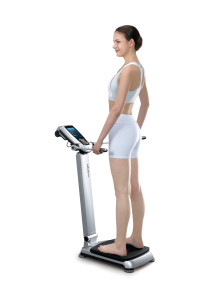Who doesn’t own a scale, or have access to one? While weight is a useful measure of overall health, it reveals nothing of our body composition. The most common body composition estimate is the body mass index, or BMI. However, BMI is simply a function of height and weight, ignoring body type (broad shoulders, for example, get missed because BMI doesn’t incorporate width or depth of the patient). As a result, the BMI misclassifies as either normal, overweight or obese some 25% of men and 48% of women, according to a recent study published in the journal PLoS One.
Tools for reliably measuring body composition are now more accurate and available than ever. For example, multi-frequency bioelectrical impedance analysis provides users with accurate measures of body fat mass, fat free mass, and total body water. Baskin Clinic now offers this analysis for patients, using the InBody 230 machine. Knowing your percentages in all these categories can provide a clearer picture of health and obesity-related risk factors than the BMI alone.
A study from Mayo Clinic found that more than half of people classified as ‘normal weight’ using BMI had excessive body fat, coining the new term normal weight obesity to describe the group.
Regardless of body type, excessive body fat has been shown to signal health risks, such as: cardiovascular risk factors, high cholesterol, pre-diabetes, and type 2 diabetes. Since BMI is such a rough estimate, body composition testing is more appropriate for assessing personal health.
Body composition testing is also a great tool to use for monitoring progress towards health goals, such as weight loss. Ever been frustrated by the bathroom scale, while your clothes seem to fit better and better? Losing weight “the healthy way” means not just cutting weight indiscriminately, but working to sustain lean tissues while dropping fat mass. Body composition testing supplies information on how your body is changing beneath the surface, and that can make a big difference in motivation when the number on the scale gets stuck.
The InBody 230 machine reliably estimates body composition using multi-frequency bioelectrical impedance analysis. For the engineers in our readership, here’s how it works: two frequencies of low-current electricity pass through the body between eight points of contact. The machine measures the speed at which the electricity moves from point-to-point. Water is a much better conductor of electricity than fat, and so the resulting measures can be used to calculate a very good estimate of body fat mass and fat free mass. We can even see a breakdown in distribution among various segments of the body.
Take our holiday challenge: test your body composition before and after all those events to see if you’ve held your ground! The test only takes about 30 seconds to complete. There are some simple preparations you must follow on the day of testing to ensure accurate results. For more information, contact shane@baskinclinic.com.

